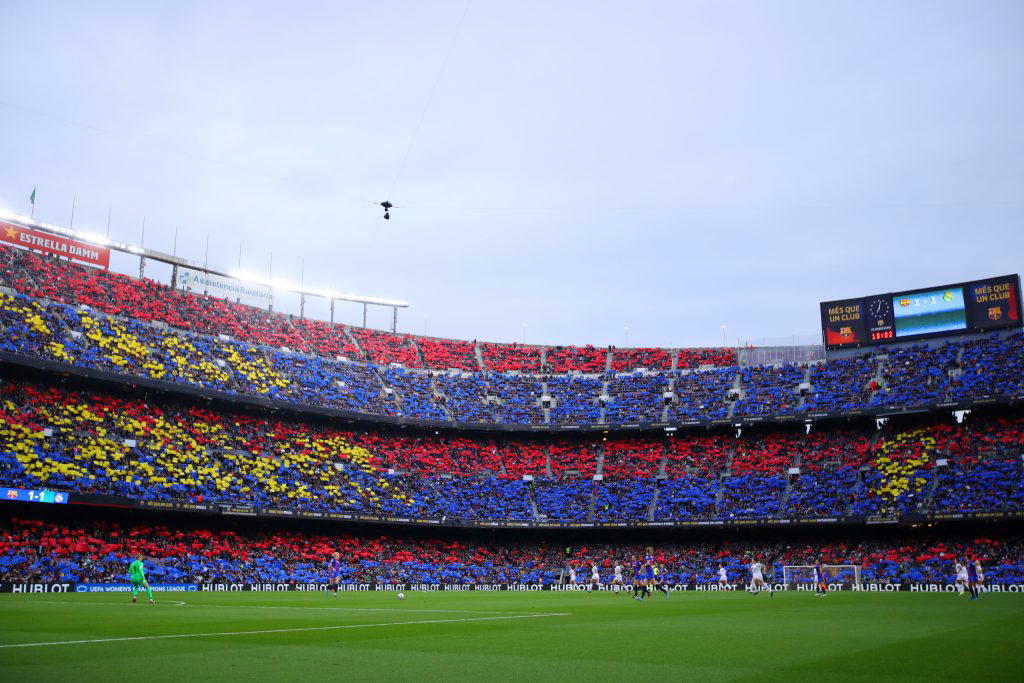10 biggest football stadiums in Europe

Europe is home to some of the most remarkable football stadiums in the world, where history, culture, and passion collide on a grand scale.
These colossal arenas not only serve as the backdrop for thrilling matches but also symbolize the deep-rooted love for football across the continent.
From the architectural marvels in Spain to the footballing cathedrals of England and Italy, Europe boasts stadiums that can hold tens of thousands of fans, creating an electrifying atmosphere unmatched anywhere else.
In this article, we explore the 10 biggest stadiums in Europe.
1. Camp Nou
Originally meant to be called “Estadi del FC Barcelona,” the stadium became known as Camp Nou to set it apart from the old Les Corts stadium. Its capacity has changed over time, peaking at 120,000 for the 1982 World Cup before being reduced due to new safety rules. Camp Nou is currently undergoing a £1.25 billion renovation and will reopen in 2025 with a retractable roof, solar panels, and a capacity of 105,000.
Though it has hosted two Champions League finals, the stadium could finally host a World Cup final in 2030 when Spain co-hosts with Portugal and Morocco.
2. Wembley Stadium
The home of the English national team, located in London capacitating 90,000 people and currently stands not only the largest in the United Kingdom but in Europe. The ground was opened on 9th of March of 2007 replacing the old Wembley Stadium that was brought down in 2003. It was the temporal home of Tottenham Hotspur from 2017-19. The stadium also hosts finals of FA cup semi-finals and finals also the finals of the Carabao cup.
3. Estadio Santiago Bernabeu
Bernabeu, the stadium owned by the most successful football club in football history, Real Madrid, the stadium is open to capacitate 85000 fans every matchday. The stadium was originally opened in 14th December 1947 but was reopened in December 2023 after a renovation that saw the installments of a retractable pitch, retractable rooftop and an increase in capacity.
4. Signal Iduna Park
The home of Borussia Dortmund, also known for its legendary name, the yellow wall. The epithet comes from the vibrant atmosphere from the Borussia fans. The stadium boasts a capacity of 81, 365 (seated and standing). Opened in 1974, it has hosted the 2001 UEFA Cup Final and World Cup matches in 1974 and 2004 but has never hosted a Champions League final.
5. Stade de France
Located in Saint Denis, France, this is the home of the French National team with stadium holding up to 80,000. The recently held the finals of the 2022 Champions League which saw Real Madrid come out victorious against Liverpool. The match that saw about 200 people injured due to shoddy planning and policing.
6. Luzhniki Stadium
Home ground of steady rivals, CSKA Moscow and Spartak Moscow has been in existence since 1956 but was rebuilt in 2017 ahead of 2018 World Cup in Russia. It can hold up to 78,000 spectators, located in Moscow, Russia.
7. San Siro
Located in Milan, Italy, the stadium is shared by the two biggest clubs in the city, Inter Milan and AC Milan. Hosting up to 80,018 people. The Stadium is also called Stadio Giuseppe Meazza, he was a player that played for both Milan sides and was a two-time World Cup winner.
8. Ataturk Stadium
The Stadium where Manchester City won their first Champions league and the historical 3-3 comeback of Liverpool against AC Milan in the 2005 UCL final. The stadium has the capacity to accommodate 77,000 spectators. The stadium was opened in 2002 and is home to many Turkish teams.
9. Old Trafford
Manchester United home ground, boasting as the biggest stadium owned by an English club. Also known as the “theatre of dreams” by club legend Bobby Charlton has the capacity of 76,000. It was first opened in 1910 being one of the oldest stadiums in United Kingdom. The stadium of recent has been under some neglect due to lack of repair in some areas around the stadium.
10. Allianz Arena
Home to the biggest Bundesliga club, Bayern Munich, known for its exterior stadium design that frequently changes colours. Opened in 2005 with the capacity of 75,000.
The post 10 biggest football stadiums in Europe appeared first on Vanguard News.




